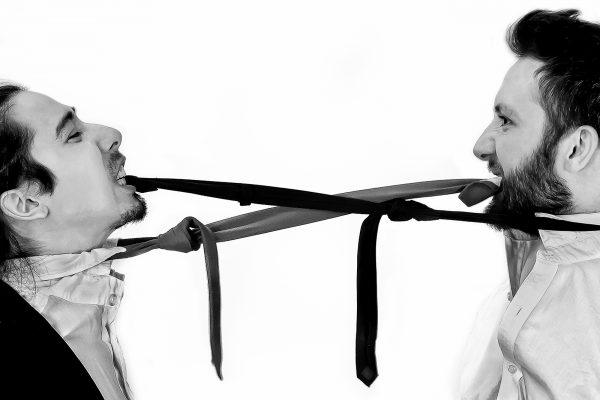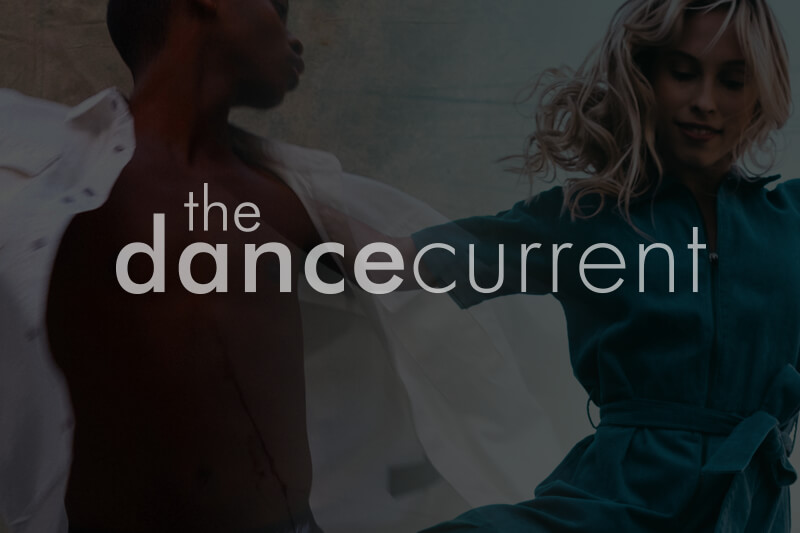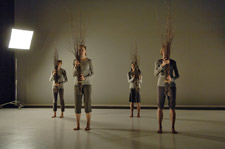Tolentino’s new work, “AdamEve/Man-Woman”, is a sixty-minute duet, a long movement poem, and a taut meditation on the body in response to evolving forms of masculinity and femininity. The one-act work is performed by the beautiful Alison Denham, a fluid, contemporary dancer, and the handsome Billy Marchenski, a sinewy, talented actor-dancer.
The choreographic scenes, or poem stanzas, are marked simply by two- to three-second blackouts; Denham and Marchenski remain yoked throughout the work, like yin and yang, always on stage, always in relationship, and always connected, or disoriented by their disconnection.
The dance opens with Denham and Marchenski in silhouette entering slowly from centre left and right. As the lights come up, the outline of the two moving bodies becomes clearer and we realize Denham and Marchenski are naked. The sound of viola is plucked, percussive, and matches the effort of the dancers to maintain an upright stance. This scene seems to reference evolution, humanity’s slow transformation from animal to human. We become aware of the whiteness of the performers’ bare skin, and the vulnerability of their bodies. We are given the chance to study moving skeletons covered in flesh: how intriguing is the ribcage, the back of the neck when released, the structure of the pelvic girdle. There is a quality in the way this nakedness is revealed and sustained that successfully transforms Denham and Marchenski into Woman and Man.
The next scene startles our acceptance of nakedness. Denham reappears dressed in a pink clingy shift with a flounce hem and spiked high heels. Posing with confidence in the ultra-feminine shoes, she tosses her long hair and smiles seductively, almost becoming Sarah Jessica Parker from Sex in the City. While Denham mimes stereotypes of feminine poses, Marchenski, dressed in an unbuttoned, checkered shirt, asserts stereotypical masculinity by picking up a gun with authority and shooting randomly into the air. Denham undresses and dresses in frantic attempts to capture Marchenski’s attention, seizes the gun and allows Marchenski to “teach” her how to shoot, slipping inside the curvature of his arms. We know how this will go, and after a momentary blackout, bold lights expose Denham and Marchenski lounging on the floor, post-coitus, content with each other, his head in her lap, the gun standing erect, pointed upright in Denham’s hand.
This snapshot is, I believe, the only lapse into parody within the entire work. For the most part, Tolentino dispenses with techniques such as irony, parody and similar conventions that have become common fare in contemporary dance composition. Instead, he chooses to otherwise not break the tension with amusing, entertaining vignettes, or by assigning “tricks” to the dancers.
The sense of tautness that the performers and the choreography sustain throughout the work is supported by Jeff Corness’ sound design. Rarely, and barely, does the movement trajectory resolve or relax into lyricism, and the dissonant sound and music choices that Corness recorded with audio manipulation software keep us emotionally poised on the edge of a seventh chord, always seeking but never finding a hallelujah in a chord of resolution.
Tolentino has created and accumulated a body of work over the last decade that has often investigated gender and/or identity. In the past, he has created with layers of sound/music, wild costumes, prose, text, video and multimedia that are woven into, or support, the dance. With “AdamEve/Man-Woman”, Tolentino dispenses with this, and like an artist returning to a palette of primary colours determined to fully understand each shade before delighting in the permutations, he remains focussed on the philosophical movement inquiry set before us.
In subsequent scenes, Denham and Marchenski appear in simple black briefs and the remainder, most of the work, is danced in this apparel, which effectively serves to reduce the emphasis on sex differences, allowing us to perceive these bodies, while obviously gendered, in a more expansive way. A subtle and invisible elastic band connects Denham and Marchenski throughout this dance; they move together and apart, exploring each other, experiencing space with and without the other, perpetually becoming one only to differentiate into two again. Tolentino uses the floor a great deal, and much of the movement vocabulary requires the dancers to fold in and out of the floor; at times the body is a starfish, spread wide open with the torso exposed, at other times, standing, the limbs are closed inward, protecting and defending the self.
There are no big jumps, leaps or gravity-defying movements, rather the phrases are short, unadorned and involve the dancers moving into each other, against each other, and finding ways to be separate from each other while often standing or lying parallel, side by side. A few times the dancers find stillness with each other, seated on the floor with legs straight forward and Denham nested between Marchenski’s legs, but this is momentary, and like the mystery of nature’s evolution, change pushes them apart. In another moment, Denham lies on top of Marchenski, who is on the floor, yielding into him, head to toe; in another they throw their torsos and chests into each other, bouncing back and trying again. In several scenes, Denham throws her legs around Marchenski’s waist and they merge briefly, only to separate and continue their respective explorations. Once, Marchenski lifts Denham from the floor and she gorgeously holds her seated position, hovering in mid-air.
Like the choreography and sound, James Proudfoot’s lighting design emphasizes the theme of polarity by rarely giving in to soft, coloured or diffused lighting tones. The contrasts evoked with bright whites and blackouts cleverly references masculinity and femininity, and, I think, only once are we given a soft blue hue in which to relax.
Often Tolentino has the dancers move along the diagonal lines of the stage, but just as frequently they move in straight vertical lines upstage and back downstage again. There is a curious repetition we become accustomed to in witnessing these directional pathways, and I wonder if these movement lines are akin to historical lines, the inevitable push of human evolution changing the face of gender, polarity ever-present, infinitely manifesting different expressions of spirit at play. Through Tolentino’s minimalist approach, this is the resonance I am left with.
In the last scene, Denham and Marchenski stand side by side and then move slowly backwards with simple, beautiful walks. They pause at upstage centre, side by side, facing the audience, and then break into a run, rushing downstage towards us, white flesh and black briefs. Their silhouettes are lit, the light changes to darkness briefly as they retreat, and then the two bodies are back in light again.
Tolentino finds a surprising “aha” ending. Denham and Marchenski move apart from their positions downstage centre, and step onto white risers at the left and right corners of the stage. Each performer stands under a spotlight, angled slightly toward the audience as though to include all of us. They pose in silence, their bodies familiar now, generously inviting our gaze, the feminine and the masculine in each, two powerful, compassionate energies.
Tagged: Contemporary, Performance, BC





